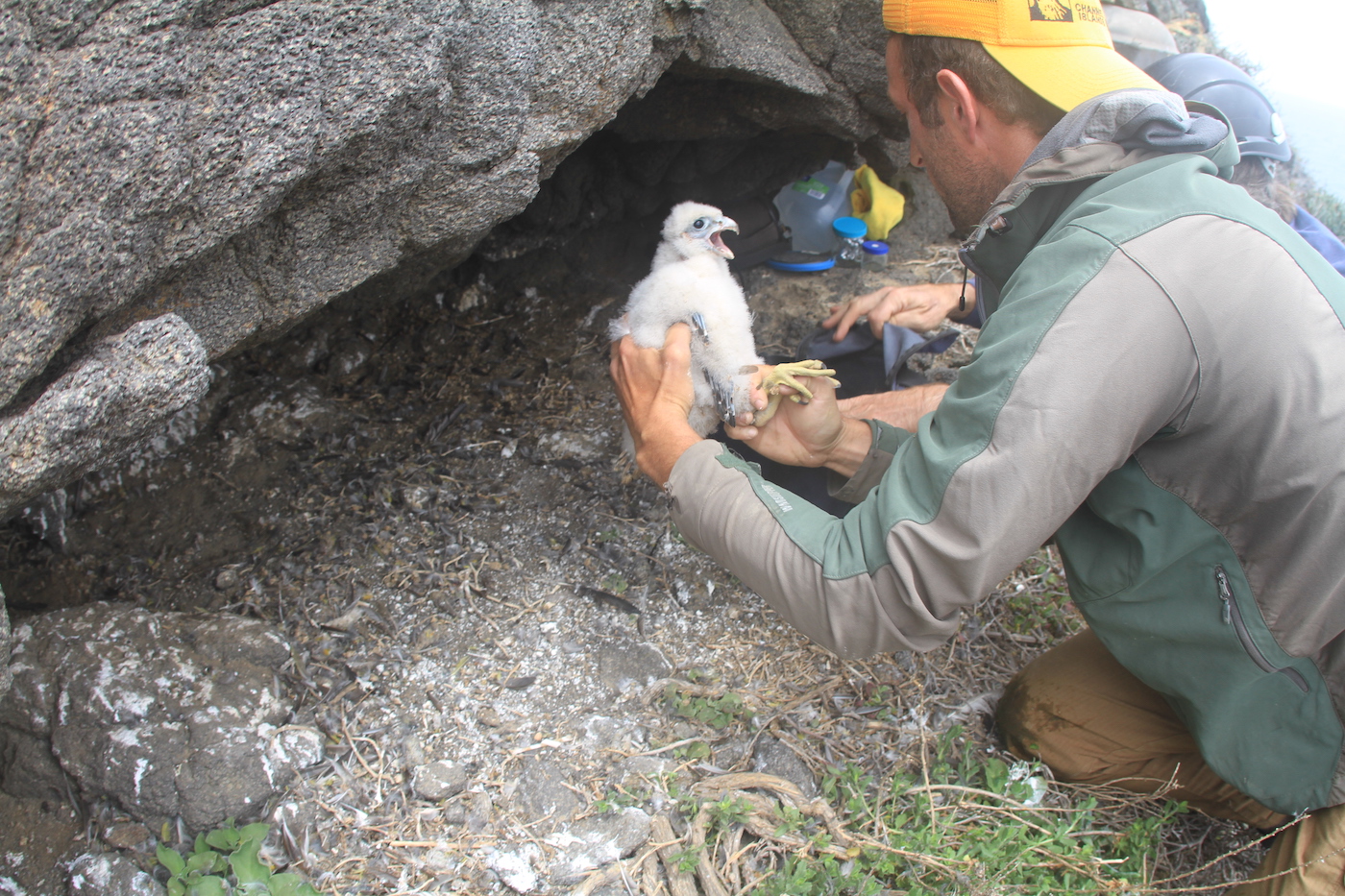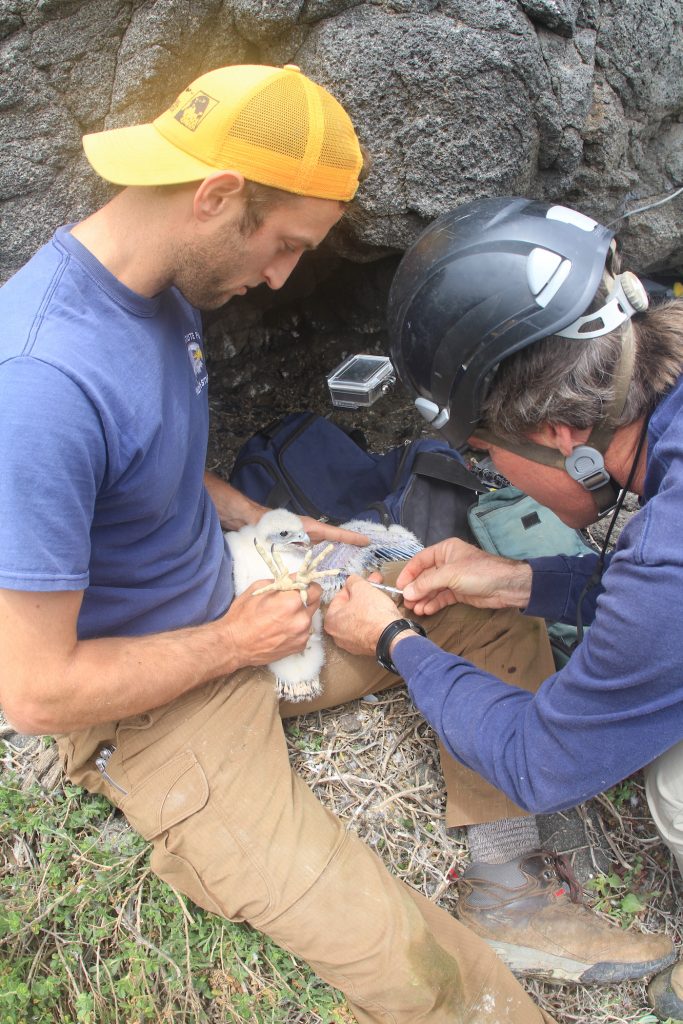My Wandering Pilgrim

My early morning trail run up to Montanon Ridge on the southeast end of Santa Cruz Island was at a pace I wasn’t proud of.
Cold, wet fog swirled over the volcanic isle. My joints ached but loosened with each stride above Potato Harbor, then Coche Point, and finally ascending above Chinese Harbor. Stunning seascapes diverted any discomfort as my pace quickened on the lonely single track leading to one of the best views across the entire Channel Islands National Park.
It’s rare to see anyone on this 10-mile loop. The route was recently added as the Montanon Ridge Loop Trail to the Park Service map. For decades, the trail was considered only as a social trail, or an old sheep trail during the island ranching era, but finally turned game trail for endemic island foxes and island spotted skunks alike. I certainly wasn’t expecting to see a soul at first light on the most biodiverse isle in the National Park.
However, once I topped out on the narrow, nameless ridge that leads to Montanon Ridge, I was greeted by a binocular toting, pack-laden biologist.
“Have you seen any peregrine falcons while on your run this morning?” asked the smiling, yet keen, blonde-haired scientist.
“I have not,” I replied. “Not so far.”
We traded peregrine stories, the raptors that frequent nearby Scorpion Rock and feast on western gulls and their fuzzy chicks, and the peregrines that hover above the sheer, wave-battered cliffs of Potato Harbor. And then there’s the pair on East Anacapa Island that have become one of the webcam stars found on the website of the Channel Islands National Park.
“I left the Navy site at dawn,” she continued. “I’m doing a survey to determine their territories and recovery.”
I was easily intrigued. Peregrines had always been a favorite raptor of mine. They are found on all continents except Antarctica, and they are without question the fastest flying bird in the world, reaching speeds during a dive that exceeds 200 miles per hour. Their recovery on the Channel Islands from DDT pesticides, was yet another successful example of natural balance returning to the northern chain.
“I’ll certainly keep an eye out,” I said. “But I usually hear them before I see one.”
She smiled and then continued her way toward breathtaking Potato Harbor, where I have seen peregrines in the past on foot but also from my kayak. As for me, I continued suffering my way toward Montanon Ridge.
They Rule the Skies
Kayaking toward Cavern Point between Scorpion Anchorage and Potato Harbor, the drama came without warning. A belted kingfisher was in serious distress. Not 25 feet off my bow, the lone kingfisher species in North America had just been clipped midair by a peregrine falcon and landed awkwardly in the ocean. However, this was the kingfisher’s lucky day. A bird that size hit by a peregrine wouldn’t usually survive. At the very least the bird would be too injured to fly on, yet this resilient kingfisher not only shook off the saltwater, but also the assault. It launched out of the water and flew into a massive sea grotto with the peregrine in hot pursuit. Once safely inside the sea cave, the peregrine gave up.
On another kayaking trip, this one in early June out and around Scorpion Rock, two peregrines tag-teamed a western gull colony. The gull chicks were just days old and ripe for the taking. The first peregrine dove in and snatched one of the chicks but was instantly harassed by at least 10 western gull parents. It forced the peregrine to drop its prize as the chick tumbled down a cliff facing the island as the gull parents chased the peregrine away.
Unbeknownst to the rest of the gulls, another peregrine lurked nearby on a lichen-cloaked cliff adjacent to Scorpion Rock. It pounced on the opportunity and swooped in to gather the bedraggled chick, carrying it off to one of the many weather-beaten caves honeycombed throughout the sheer cliffs on the north side of the isle.
Turnabout is Fair Play
The Channel Islands National Park has several webcams for visitors to watch active wildlife from the comfort of their homes, citizen science in all its glory. There’s the underwater cam in the Landing Cove on East Anacapa Island. There’s the bald eagle cams out on the remote west end of Santa Cruz Island. And there’s the peregrine cam above Cathedral Cove on East Anacapa Island.

During May 2018, that peregrine nest produced three fuzzy white peregrine chicks. Their parents have had this nest for a while now, strategically tucked away from the weather: wind, rain, and fog.
On one occasion, during that late spring, I was fortunate enough to accompany Institute for Wildlife Studies (IWS) biologists Peter Sharpe and Nathan Melling to East Anacapa. They were on a routine inspection of the nest (eyrie) to give checkups to the peregrine chicks and wipe down moisture that had built up on the lens of the webcam.
When we arrived at the eyrie, we discovered only two chicks. Their dutiful parents watched us with keen eyes, and then like good parents should, they protected their fuzzy chicks. The peregrines repeatedly dive-bombed us, several times coming within a wisp of clipping my head, shoulder, and neck. It surely felt like 200 miles per hour. There wasn’t a whole lot of room to hunker down, the nest rises a couple hundred feet above Cathedral Cove, and with Sharpe and Melling sitting around the chicks, all I could do was stand hunched over, photograph the checkup and dodge the pissed off parents.
Sharpe and Melling attached tracking devices and drew a little blood from each chick. Within 20 minutes all was calm again around the eyrie. The parents watched us leave as we continued searching for more peregrines while hiking through throngs of nesting western gulls.
The rest of the afternoon was spent looking for other peregrines. We spotted another breeding pair on the south side of the island, as they swooped back and forth just west of the lighthouse. From the top of the marine terrace, none of us could spot an active nest, but there had to be one concealed in the sheer, pockmarked cliffs. Sure enough, back on the Vanguard, we motored around the iconic 40-foot tall archway to the south side of East Anacapa. Melling was standing on the bow, scanning with his binoculars.
“There it is,” he pointed three quarters of the way up the cliff. “There’s a peregrine chick sitting on the edge of its nest.”
Standing out like nothing else could, an older, bigger, fuzzier, white peregrine chick stood alone, teetering on the edge of its eyrie, its parents could still be seen riding the thermal updrafts that continually swirl around the narrowest islet in the chain.
Epilogue
But whatever became of that third chick from the nest above Cathedral Cove?
Sharpe and Melling returned to their office, put on their detective hats, and rewound the webcam tape. A brazen, adult western gull was the culprit. It had seized an opportunity like no other.
At the time of perpetration, it was obvious the peregrine parents were not around doting over their young. The tape showed the gull landing in the eyrie and quickly snatching one of the three chicks. A very bold move by a gull and turnabout being fair play.







